Did you know Bangladesh is full of amazing historical buildings and landmarks? It has a rich culture that goes back centuries. This South Asian country is home to many architectural wonders that have lasted for a long time. Get ready to explore the top 10 historical buildings and landmarks that show off Bangladesh’s lasting legacy.
The preservation of our historical buildings and landmarks is not just about preserving bricks and mortar, but about preserving the soul of a nation.
Key Takeaways
- Bangladesh’s historical buildings and landmarks offer a window into the country’s captivating cultural heritage.
- These iconic structures range from ancient fortresses to stunning mosques and monasteries, each with a unique story to tell.
- Exploring these landmarks provides a deeper appreciation for Bangladesh’s enduring architectural and historical legacy.
- Many of these sites have been recognized as world heritage sites, highlighting their global significance.
- Preserving and showcasing these historical treasures is crucial for maintaining Bangladesh’s cultural identity and inspiring future generations.
Unveiling Bangladesh’s Architectural Heritage
Bangladesh’s architecture is a mix of rich culture and history. It shows the country’s blend of styles from the Mughal era to Islamic and Buddhist designs. Each building tells a story of the nation’s architectural beauty.
A Journey Through Time
Start a journey through Bangladesh’s ancient architecture. See how the past and present meet in these structures. Each one has a story, showing the country’s diverse culture and its love for preserving history.
Timeless Wonders of the Past
See the ancient gems that have lasted for centuries. From the grand Lalbagh Fort to the Sixty Dome Mosque, these sites show the evolution of architecture in Bangladesh. They are key to understanding the country’s cultural and architectural heritage.
| Sl No | Historical Monument | Architectural Style | Location | Situated Year | Significance |
| 1 | Lalbagh Fort | Mughal Architecture | Dhaka, Bangladesh | 17th-century 1678 | A grand 17th-century fortress that showcases the cultural heritage and historical monuments of Bangladesh. |
| 2 | Ahsan Manzil | Indo-Saracenic Revival | Dhaka, Bangladesh | 1872 | Former official residential palace of the Nawabs of Dhaka; a symbol of Dhaka’s heritage. |
| 3 | Sixty Dome Mosque (Shat Gombuj Masjid) | Tughlaq and Islamic Architecture | Bagerhat, Bangladesh | 15th Century | A masterpiece of architectural ingenuity, this 15th-century mosque is a testament to the country’s rich Islamic architectural legacy. A UNESCO World Heritage Site and one of the largest mosques in Bangladesh, renowned for its unique dome structure. |
| 4 | Somapura Mahavihara | Buddhist Architecture | Paharpur, Bangladesh | 8th Century | A UNESCO World Heritage Site, this ancient Buddhist monastery reveals the grandeur of historic preservation and the cultural heritage of Bangladesh. |
| 5 | Mainamati Ruins | Buddhist Architecture | Comilla, Bangladesh | 7th-12th Century | An archaeological site featuring the remains of ancient Buddhist civilizations. |
| 6 | Mahasthangarh | Ancient Hindu-Buddhist | Bogra, Bangladesh | 3rd Century BCE | One of the earliest urban archaeological sites in Bangladesh. |
| 7 | Star Mosque (Tara Masjid) | Mughal and Islamic Architecture | Dhaka, Bangladesh | 18th Century | A beautiful mosque adorned with star-shaped mosaic designs, representing Islamic art and Mughal architecture. |
| 8 | Kantaji Temple | Terracotta Hindu Temple | Dinajpur, Bangladesh | 18th Century | A stunning example of terracotta architecture, dedicated to the Hindu god Krishna. |
| 9 | Curzon Hall | Indo-Saracenic Revival | Dhaka, Bangladesh | 1904 | A historic building now part of the University of Dhaka, symbolizing British colonial architecture. |
| 10 | Liberation War Museum | Contemporary | Dhaka, Bangladesh | 1996 | A museum dedicated to preserving the history and memories of the Bangladesh Liberation War of 1971. |
Learn about the iconic structures of Bangladesh. Discover the lasting impact they have on the country’s architecture. Dive into the world of historical monuments and see the beauty of ancient architecture.
1. The Lalbagh Fort: A Mughal Marvel
Mughal Architecture | Dhaka, Bangladesh | 17th-century
In the heart of Dhaka, the Lalbagh Fort is a stunning example of Mughal architecture. This 17th-century historical monument mixes ancient architecture and architectural marvels. It shows the beauty of Bangladesh’s iconic structures.
Mughal Prince Muhammad Azam Shah built the Lalbagh Fort as a palace and fortress. Its high walls have detailed carvings and decorations. The fort’s main feature is the beautiful Lalbagh Mosque. It’s a Mughal architecture gem with three domes and two tall minarets.
Walking through the fort, you’ll see how military strength and art come together. The peaceful Lalbagh Garden has beautiful paths and quiet fountains. It’s a calm spot away from the city’s noise.
The Tomb of Bibi Pari is a key spot in the fort. It’s where a Mughal princess is buried. The tomb’s marble work and arches show the Mughals’ skill.
The Lalbagh Fort is a true architectural masterpiece, a testament to the Mughal Empire's enduring legacy in Bangladesh.
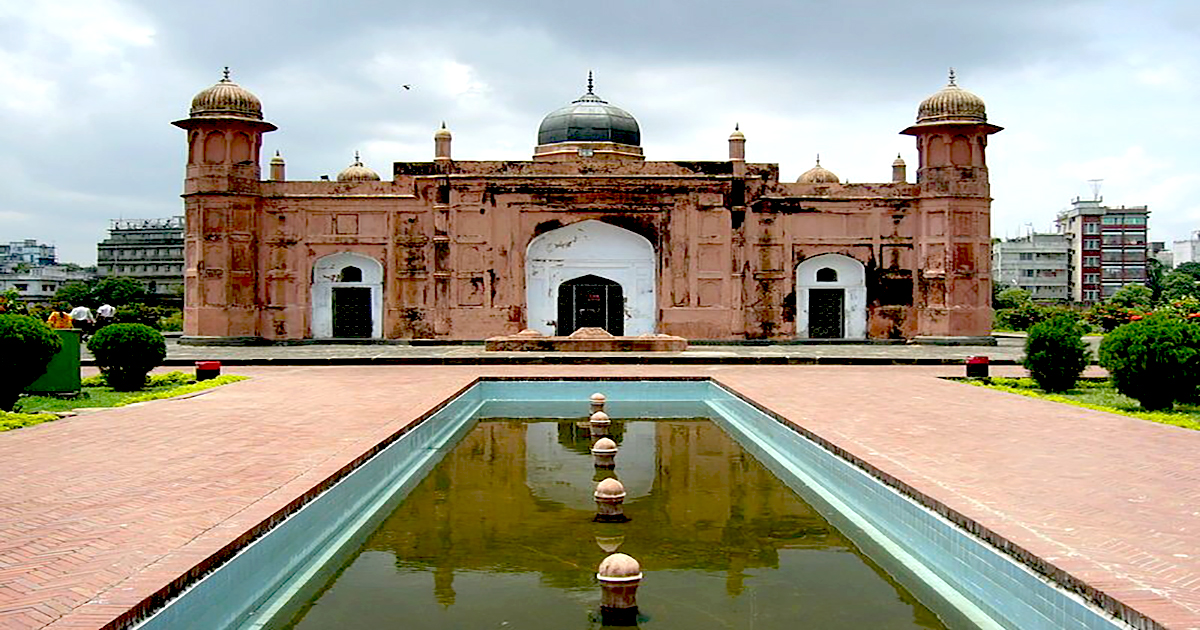
For More Info Please Visit: Lalbagh Fort
2. The Ahsan Manzil: A Stunning Fusion of Styles
Indo-Saracenic Revival | Dhaka, Bangladesh | 19th-century (1859-1872)
The Ahsan Manzil sits by the Buriganga River in Dhaka. It’s a mix of European and Mughal styles. This 19th-century (1859-1872) building shows how Bangladesh combines different cultures into its landmarks.
The Ahsan Manzil highlights Bangladesh’s skill in ancient architecture and engineering. Built in the late 1800s, it combines Mughal and European styles. This makes it a beautiful and balanced structure.
Architectural Brilliance on the Riverbank
The palace’s pink façade catches the eye right away. It has arched windows, domes, and detailed designs. These features make it a standout in Bangladesh.
The Ahsan Manzil stands as a testament to Bangladesh's artistic and engineering prowess, captivating visitors with its grandeur and timeless beauty.
Inside, you’ll see how Mughal and European styles work together. There are ornate ceilings, carvings, and chandeliers. It feels like stepping back in time to a significant historical era.
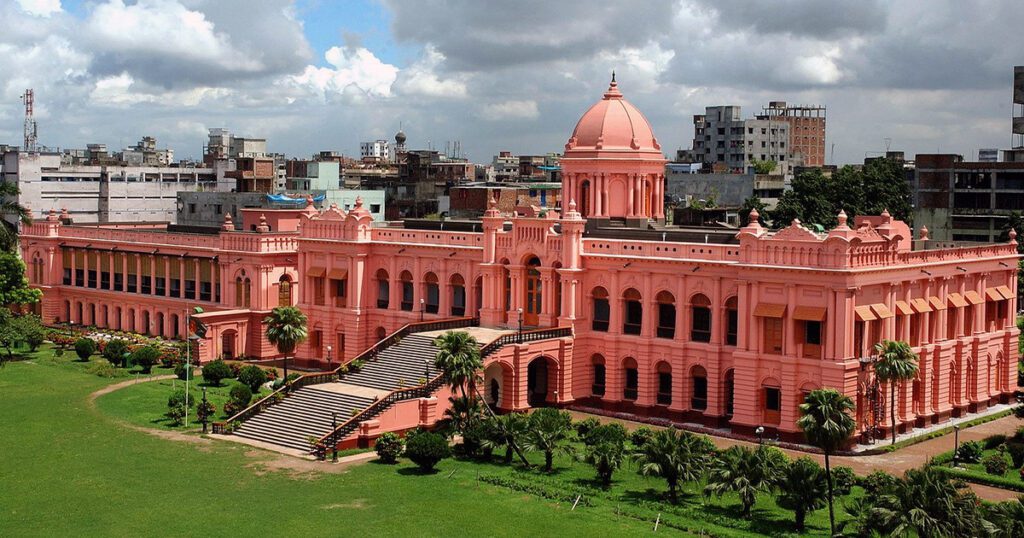
The palace is by the Buriganga River, adding to its beauty. It lets visitors see the palace’s grandeur and nature. This mix of nature and architecture makes the Ahsan Manzil a key part of Bangladesh’s culture.
For more info please visit: Ahsan Manzil
3. Sixty Dome Mosque: A Masterpiece of Islamic Architecture
Tughlaq and Islamic Architecture | Bagerhat, Bangladesh | 15th-century
Bangladesh is home to many historical landmarks, and the Sixty Dome Mosque in Bagerhat is a prime example. Built in the 15th century, it shows off the country’s rich cultural heritage. Its intricate designs and tall domes make it a sight to behold.
Sixty Dome Mosque also known as Shat Gombuj Masjid by the local people.
During the Sultani era, Islamic architecture was at its peak in the region. The Sixty Dome Mosque is a masterpiece from that time. It highlights the skill of the era with its:
- Sixty ornate domes, each one a unique work of art
- Intricate carvings and decorative elements that adorn the walls and ceilings
- A harmonious blend of Islamic and local architectural styles
- Immense scale and grandeur, with the mosque covering an area of over 5 acres
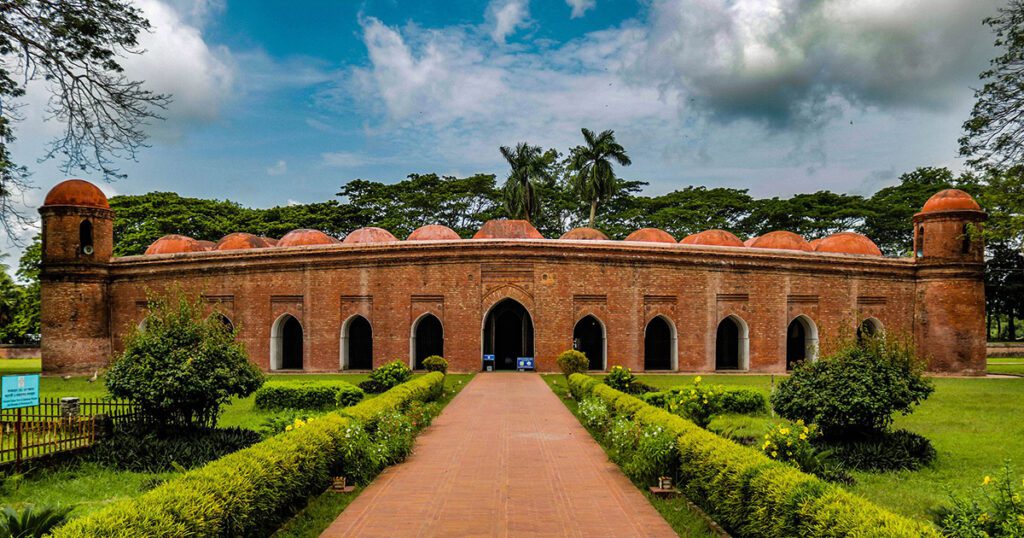
People visiting the Sixty Dome Mosque are often amazed by its beauty and history. It’s a symbol of Bangladesh’s deep cultural and religious roots. Its timeless beauty captures the hearts of all who see it.
| Architectural Feature | Description |
| Domes | The mosque features an impressive 60 domes, each one unique in its design and craftsmanship. |
| Carvings and Decorations | The walls and ceilings of the mosque are adorned with intricate carvings and decorative elements, showcasing the skilled artistry of the era. |
| Architectural Styles | The Sixty Dome Mosque blends Islamic architectural styles with local influences, creating a harmonious and visually stunning structure. |
| Scale and Grandeur | The mosque covers an area of over 5 acres, exemplifying the scale and ambition of the Sultani era’s architectural achievements. |
The Sixty Dome Mosque is a true gem of Islamic architecture in Bangladesh. It’s a cultural site that leaves a lasting impression on all who see it.
The Sixty Dome Mosque is a stunning example of the remarkable architectural achievements of the Sultani era in Bangladesh. Its intricate designs and towering domes are a true testament to the skilled craftsmanship of the past.
For more info please visit: Sixty Dome Mosque
4. The Somapura Mahavihara: A Buddhist Treasure Trove
Buddhist Architecture | Paharpur, Bangladesh | 8th-century
In Paharpur, Badalgachhi, Naogaon, Bangladesh, the Somapura Mahavihara is a key historical site. It shows the area’s rich culture and history. This Buddhist complex is a UNESCO world heritage site, taking you back in time.
It was built during the Pala dynasty, showing off the era’s architectural skill. Visitors can see many ancient buildings and detailed carvings. Each piece tells a story of the site’s spiritual importance and the efforts to keep it safe.
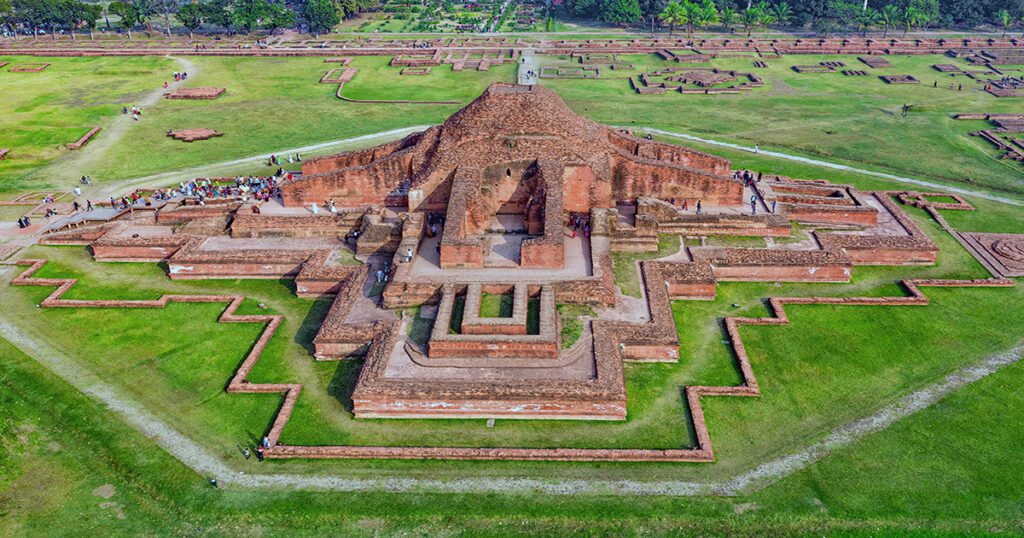
Rediscovering Ancient Spiritual Grandeur
Walking through the Somapura Mahavihara, you’ll feel the calm and the grandeur. It has many monasteries, temples, and stupas. It feels like stepping back in time and connecting with the past.
The Somapura Mahavihara is a true testament to the enduring spirit of Bangladesh’s Buddhist architecture and the resilience of its historical buildings and landmarks.
See the detailed sculptures and inscriptions at the site. They tell the story of this place’s history. The Somapura Mahavihara shows the lasting spirit of Bangladesh’s history. It invites visitors to rediscover the ancient spiritual grandeur of this special place.
For more info please visit: Somapura Mahavihara
5. Mainamati Ruins
Buddhist Architecture | Comilla, Bangladesh | 7th-12th century
The Mainamati Ruins, located in the Comilla district of Bangladesh, are an ancient archaeological site that dates back to the 8th to 12th centuries. This historic area is part of the larger Lalmai-Mainamati range, which is renowned for its Buddhist monastic complex. The ruins cover a series of low hills, with the most prominent being the Shalban Vihara, a large Buddhist monastery that served as the center of religious, cultural, and educational activities during its time..
Excavations at Mainamati have revealed more than 50 ancient structures, including stupas, temples, and monasteries, showcasing the architectural and cultural richness of the region. The terracotta plaques, stone sculptures, and bronze relics found at the site provide valuable insights into the religious art and practices of the early medieval period in Bengal.
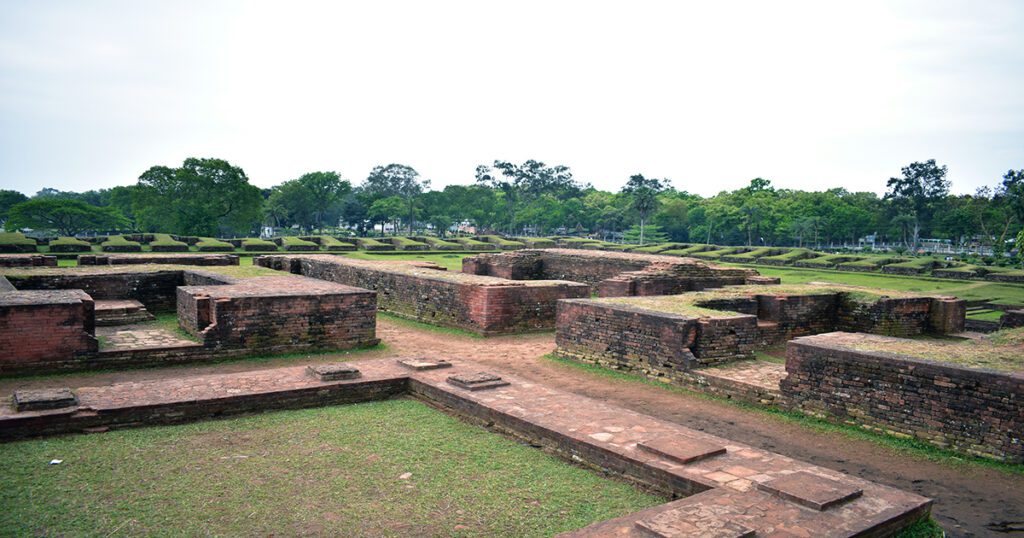
Mainamati is also famous for its association with the ancient Vanga Kingdom, and the ruins are considered one of the most important archaeological discoveries in South Asia. The site is a testament to the region’s historical significance and its role in the spread of Buddhism in the Indian subcontinent.
The Mainamati Museum houses a remarkable collection of artifacts, including bronze statues, coins, and terracotta plaques, further enriching the visitor’s experience.
6. Mahasthangarh
Ancient Hindu-Buddhist | Bogra, Bangladesh | 3rd-century
Mahasthangarh, located in the Bogra district of Bangladesh, is one of the oldest and most significant archaeological sites in the country. Dating back to at least the 3rd century BCE, Mahasthangarh was once a thriving city and the ancient capital of the Pundra Kingdom. The site is believed to be the ancient city of Pundranagara, mentioned in various historical texts, including the Mahabharata and early Buddhist literature.
The ruins of Mahasthangarh encompass a fortified area with massive ramparts made of mud and brick, extending over 1.5 kilometers in length. Inside the fortified city, archaeologists have uncovered remains of palaces, temples, residential areas, and other urban structures, reflecting the city’s significance as a political, religious, and cultural center.
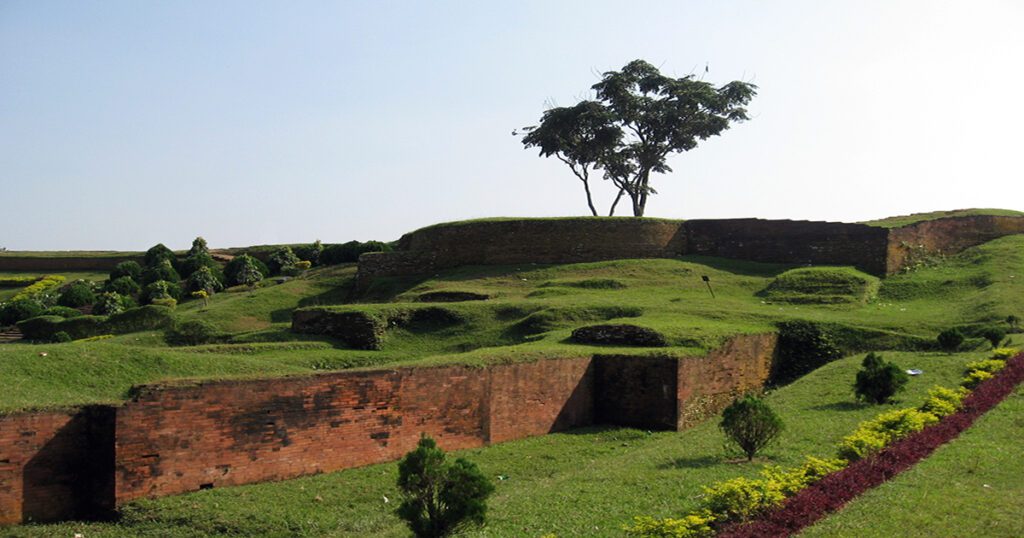
One of the most remarkable discoveries at Mahasthangarh is the Govinda Bhita temple, dating back to the 6th century CE, which provides a glimpse into the religious practices of the time. Numerous terracotta plaques, coins, inscriptions, and sculptures have been unearthed at the site, offering valuable insights into the daily life, trade, and religious beliefs of the ancient inhabitants.
Mahasthangarh Museum, which displays artifacts such as pottery, coins, and inscriptions, provide a fascinating glimpse into the early history of the region.
Mahasthangarh is also notable for its connection to both Hinduism and Buddhism, with evidence of religious coexistence and cultural exchange. The site is a testament to the rich history and heritage of Bengal, making it a key destination for those interested in exploring the ancient civilizations of South Asia.
7. Star Mosque (Tara Masjid)
Mughal and Islamic Architecture | Dhaka, Bangladesh | 18th-century
The Star Mosque, also known as Tara Masjid, is a beautiful example of Mughal-era architecture located in the Armanitola area of Old Dhaka, Bangladesh. Originally built in the early 19th century, the mosque has undergone several renovations, with the most notable being in the 1920s. These renovations added the mosque’s iconic star motifs, from which it derives its name.
The mosque’s design is characterized by intricate mosaic work made of thousands of pieces of colored glass and porcelain, which cover the walls, ceilings, and domes. The stars, crafted from broken china and blue ceramic tiles, are embedded in the mosque’s white marble surface, creating a stunning visual effect that has become the mosque’s signature feature.
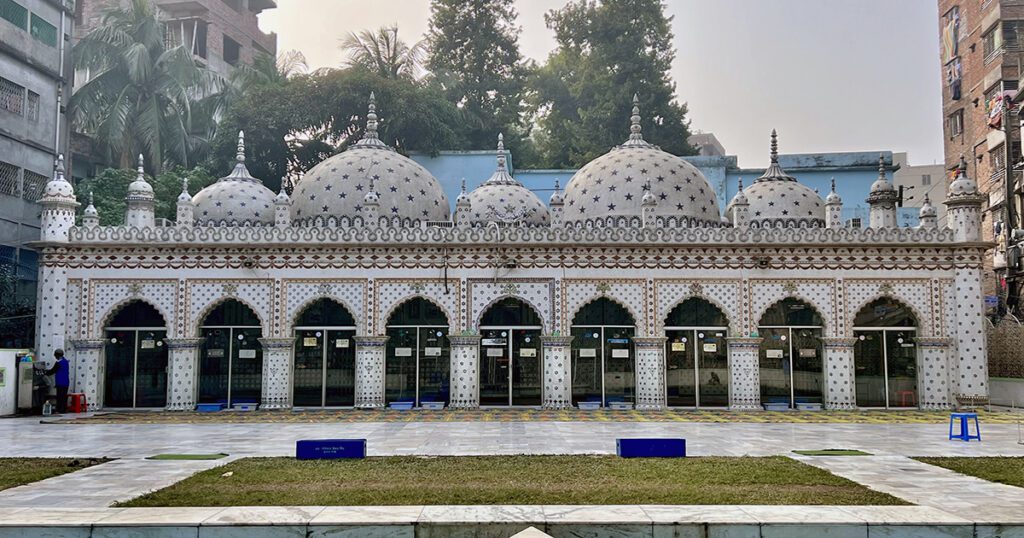
The original structure of the Star Mosque was a single-domed building, typical of the Mughal architectural style. However, later renovations expanded it to include five domes, all adorned with the starry mosaic pattern. The interior is equally impressive, with delicate floral patterns and calligraphy enhancing the mosque’s serene atmosphere.
Archaeologically, the Star Mosque stands as a remarkable example of the blending of different artistic influences, including Mughal, Persian, and local Bengali craftsmanship. It reflects the rich cultural and religious heritage of Dhaka and remains a popular site for both worshippers and visitors interested in the city’s historical landmarks.
The Star Mosque is not only a place of worship but also a symbol of the artistic ingenuity of its time, making it one of the most photographed and admired mosques in Bangladesh.
8. Kantaji Temple: A Hindu Architectural Wonder
Terracotta Hindu Temple | Dinajpur, Bangladesh | 18th-century
In the lively town of Dinajpur, the Kantaji Temple is a gem. It’s a 18th-century Hindu temple known for its detailed design. It highlights the area’s deep cultural roots.
Kantaji Temple, also known as Kantanagar Temple, is a magnificent Hindu temple located in the Dinajpur district of Bangladesh. Constructed in the mid-18th century, between 1704 and 1752, during the reign of Maharaja Pran Nath and completed by his son Maharaja Ramnath, the temple is dedicated to the Hindu deity Krishna, known locally as Kantaji.
The temple’s design and colors grab your attention. It shows off the skill and art that have lasted for ages. From its fancy front to the detailed carvings on its walls, it’s a treat for the eyes. It invites people to dive into the timeless beauty of old architecture.
The temple is renowned for its exquisite terracotta ornamentation, which covers the entire surface of the building. Every inch of the temple’s walls is adorned with intricate terracotta plaques depicting scenes from Hindu mythology, as well as everyday life, floral designs, and geometric patterns. This detailed artwork makes Kantaji Temple one of the finest examples of late medieval temple architecture in Bengal.
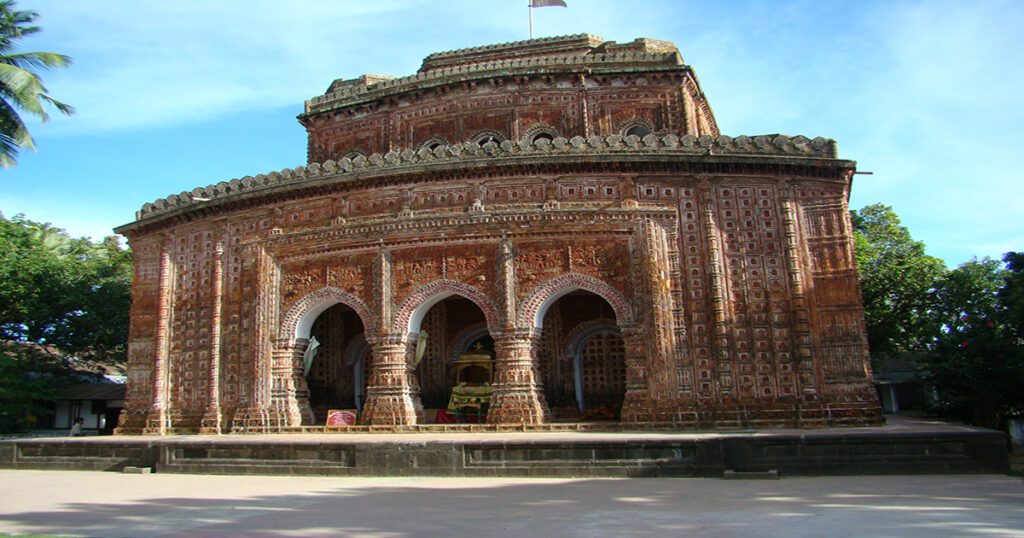
Celebrating Diversity Through Architecture
The Kantaji Temple is more than a beautiful cultural site. It symbolizes how different faiths live together in Bangladesh. As you look at its detailed design, you see the country’s amazing mix of cultures. This mix has shaped a unique architectural scene.
The temple originally featured nine spires (navaratna), a common architectural feature in Bengali temple design. However, an earthquake in the 19th century damaged the upper spires, leaving the temple with its current structure. Despite this, the remaining structure continues to captivate visitors with its grandeur and artistic brilliance.
Archaeologically, Kantaji Temple is significant as it represents the pinnacle of terracotta art in Bengal. The temple’s design follows the traditional Bengali style, with a square base and multiple tiers leading up to the now-missing spires. The terracotta panels not only highlight religious narratives but also provide valuable insights into the social and cultural life of the time.
If you love history, architecture, or just beauty, visiting the Kantaji Temple is a must. It shows the lasting impact of Hindu architecture. It also celebrates the diversity that makes Bangladesh special.
Kantaji Temple stands as a testament to the artistic and religious devotion of the period, attracting pilgrims, historians, and art lovers alike. It is one of the most important cultural heritage sites in Bangladesh, celebrated for its architectural beauty and historical significance.
9. Curzon Hall
Indo-Saracenic Revival | Dhaka, Bangladesh | 19th-century (1904)
Curzon Hall is an iconic historical building located on the campus of the University of Dhaka in Bangladesh. The hall was originally constructed in 1904, during the British colonial period, and is named after Lord Curzon, the Viceroy of India at the time. Originally intended to serve as a town hall, the building was later repurposed to house the science faculty of the University of Dhaka, which was established in 1921.
Architecturally, Curzon Hall is a stunning example of Indo-Saracenic design, a style that blends elements of Mughal, Islamic, and European architecture. The building is characterized by its red brick facade, arched doorways, and elegant balconies, along with intricate decorative details that reflect the rich architectural heritage of the region. The central hall, with its spacious interiors and high ceilings, is particularly notable for its grandeur.
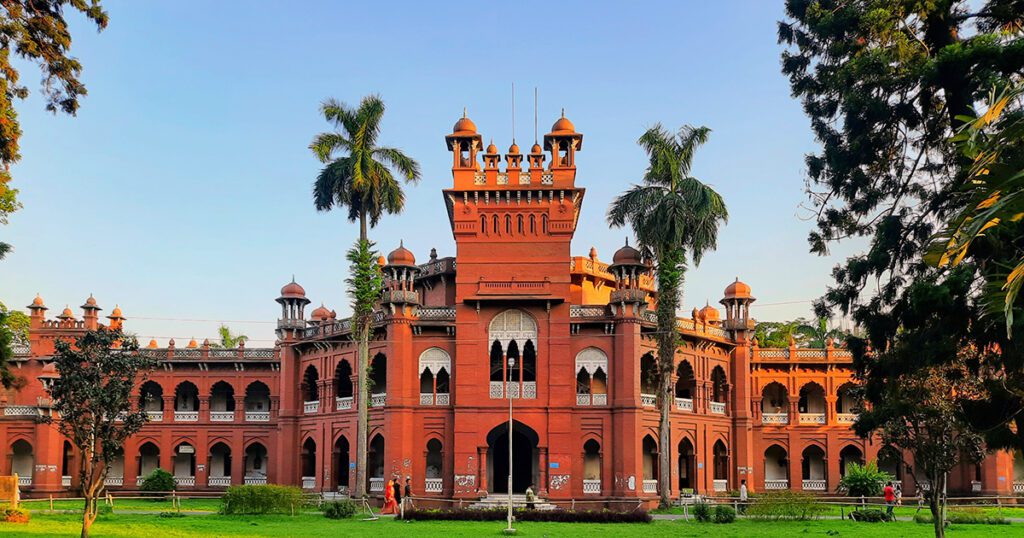
One of the most distinctive features of Curzon Hall is its blend of traditional Mughal architectural elements, such as the use of domes and minarets, with colonial British influences, making it a unique representation of the fusion of cultures during the colonial era.
Archaeologically, Curzon Hall holds significant historical value as a symbol of the educational and political history of Bangladesh. It has been the site of numerous important events, including the Language Movement of 1952, when students and activists gathered here to demand the recognition of Bengali as an official language.
Today, Curzon Hall remains an integral part of the University of Dhaka, continuing to serve as a center of learning and a cherished landmark in the city. Its architectural beauty and historical significance make it a must-visit site for those interested in the cultural and educational heritage of Bangladesh.
10. Liberation War Museum
Contemporary | Dhaka, Bangladesh | 20th-century (1996)
The Liberation War Museum, located in Dhaka, Bangladesh, is a profound institution dedicated to preserving and commemorating the history of the Bangladesh Liberation War of 1971. Established in 1996, the museum serves as a testament to the struggles and sacrifices made by the people of Bangladesh in their fight for independence from Pakistan.
The museum’s exhibits are housed in a modern, purpose-built facility that was inaugurated in 2017, designed to reflect the solemnity and significance of the events it memorializes. The architecture of the museum is contemporary, yet it evokes the spirit of resilience and freedom that characterized the liberation movement.
Inside, the museum’s extensive collection includes a vast array of artifacts, photographs, personal belongings of freedom fighters, and documents that narrate the story of Bangladesh’s struggle for independence. The exhibits are arranged chronologically, beginning with the early resistance against colonial rule, leading up to the partition of India in 1947, and culminating in the brutal and defining war of 1971.
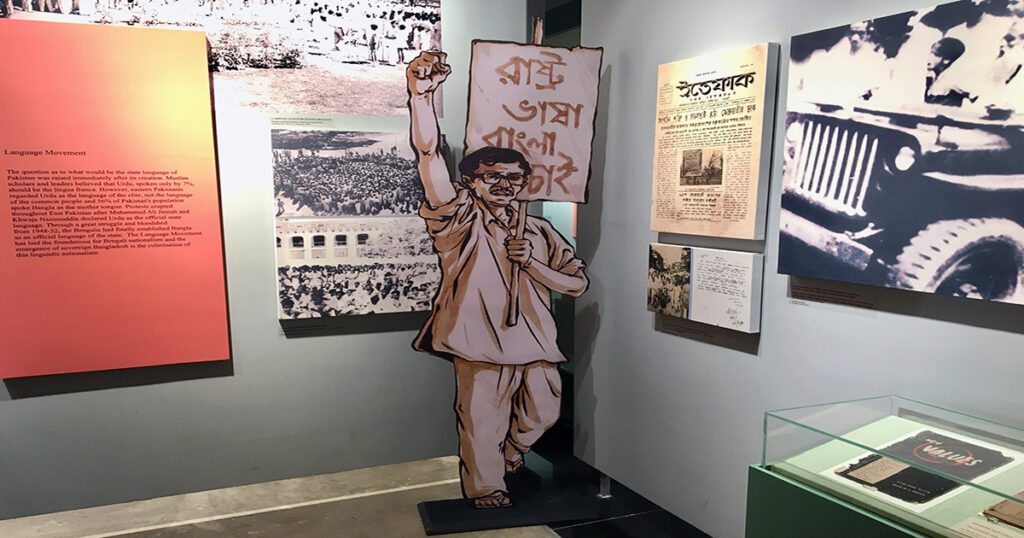
One of the most poignant sections of the museum is the gallery dedicated to the genocide that took place during the war, where over three million people were killed. This section includes harrowing photographs, witness accounts, and a display of skulls and bones recovered from mass graves, serving as a powerful reminder of the atrocities committed.
The museum also features a “Wall of Martyrs,” where the names of those who lost their lives in the war are inscribed, and a collection of rare audio-visual recordings that bring to life the memories of the war.
Archaeologically and historically, the Liberation War Museum is an invaluable resource for understanding the complex history of South Asia and the enduring impact of the Liberation War on the national identity of Bangladesh. It stands not only as a place of remembrance but also as a center for education and research, dedicated to ensuring that future generations remember and learn from the past.
Conclusion
Bangladesh is home to a rich collection of historical buildings and landmarks. These sites show the country’s deep cultural heritage. From grand Mughal fortresses to peaceful Buddhist monasteries and beautiful mosques, each structure tells a story.
Visitors can learn a lot about Bangladesh’s history, art, and spirit by exploring these sites. These buildings highlight the country’s effort to keep its culture alive and share it with the world. They are like beacons, lighting up the past and leaving everyone amazed.
As you read this article, you’ll be drawn into the stories of these iconic places. Each one shows the strength and creativity of the Bangladeshi people. From the Lalbagh Fort’s Mughal beauty to the Somapura Mahavihara’s ancient Buddhist wonder, these landmarks invite you on a journey through time.
You are welcome to read my other articles as follows
Frequently Asked Questions (FAQ)
What are the top historical buildings and landmarks in Bangladesh?
Bangladesh is known for its rich history, with many historical buildings and landmarks. You can find ancient fortresses, beautiful mosques, and peaceful Buddhist monasteries. Some top sites include the Lalbagh Fort, Ahsan Manzil Palace, Sixty Dome Mosque, Somapura Mahavihara, Kantaji Temple, Shrine of Hazrat Shah Jalal, Paharpur Buddhist Monastery, and Shat Gambuj Mosque.
What makes the Lalbagh Fort a Mughal marvel?
The Lalbagh Fort in Dhaka is a stunning example of Mughal architecture. It shows the grandeur of the Mughal Empire in the region. Built in the 17th century, it has tall walls, beautiful gardens, and fancy structures. It gives us a peek into the Mughal era’s architectural and cultural achievements in Bangladesh.
How does the Ahsan Manzil Palace reflect the fusion of architectural styles in Bangladesh?
The Ahsan Manzil Palace in Dhaka is a mix of European and Mughal styles. It’s by the Buriganga River and was built in the 19th century. This palace shows how different cultures blended in Bangladesh, making it a symbol of the country’s artistic and engineering skills.
What is the significance of the Sixty Dome Mosque in Bagerhat?
The Sixty Dome Mosque in Bagerhat is a stunning Islamic structure in Bangladesh. Built in the 15th century, it has many domes and intricate designs. It’s a symbol of the country’s rich culture and Islamic heritage. The mosque shows the skill of the Sultani era and its beauty and history.
Why is the Somapura Mahavihara in Naogaon considered a Buddhist treasure trove?
The Somapura Mahavihara in Naogaon is a Buddhist monastery with a deep spiritual history. It’s a UNESCO World Heritage Site known for its ancient structures and carvings. It highlights the Pala dynasty’s architectural and artistic skills. Visiting lets you see the beauty and importance of Bangladesh’s Buddhist past.
How does the Kantaji Temple in Dinajpur celebrate the diversity of Bangladesh’s cultural heritage?
The Kantaji Temple in Dinajpur is a beautiful Hindu temple in Bangladesh. It shows the country’s diversity in faith and culture. Built in the 18th century, it has detailed carvings and bright colors. It’s a masterpiece that celebrates the region’s artistic traditions.
What is the significance of the Shrine of Hazrat Shah Jalal in Sylhet?
The Shrine of Hazrat Shah Jalal in Sylhet is a sacred place for Muslims in Bangladesh. It honors a famous Sufi saint. The shrine shows the lasting impact of Islam and Sufism on Bangladesh’s culture. It’s a place of peace and devotion that shows the country’s religious diversity.
Why is the Paharpur Buddhist Monastery in Naogaon considered a UNESCO World Heritage Site?
The Paharpur Buddhist Monastery in Naogaon is a UNESCO site that highlights Bangladesh’s Buddhist history. It dates back to the 7th century and has many structures and artifacts. It gives us a look into the life and beliefs of ancient Buddhist communities in the region.
What makes the Shat Gambuj Mosque in Bagerhat a masterpiece of architectural ingenuity?
The Shat Gambuj Mosque in Bagerhat is a masterpiece of Islamic architecture. Built in the 15th century, it has beautiful designs and domes. It’s a symbol of Bangladesh’s Islamic heritage and artistic skills. Visitors can see the amazing details and how it combines beauty with function.




Leave a Comment